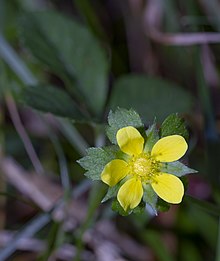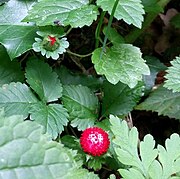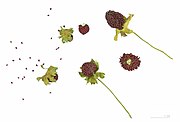| Potentilla indica | |
|---|---|

| |
| Scientific classification | |
| Kingdom: | Plantae |
| Clade: | Tracheophytes |
| Clade: | Angiosperms |
| Clade: | Eudicots |
| Clade: | Rosids |
| Order: | Rosales |
| Family: | Rosaceae |
| Genus: | Potentilla |
| Species: | P. indica |
| Binomial name | |
| Potentilla indica (Andrews) Th.Wolf | |
| Synonyms | |
| |
Potentilla indica, known commonly as mock strawberry, Indian-strawberry, or snakeberry in North America, is a flowering plant in the family Rosaceae. It has ternate foliage and an aggregate accessory fruit, similar to the true strawberries of the Fragaria genus. Unlike the white or slightly pink flowers of true strawberries, Potentilla indica has yellow flowers, as do many other Potentilla species. It is native to eastern and southern Asia, but has naturalized in many regions worldwide.
Many sources consider this plant part of the genus Potentilla due to evidence from chloroplast genetic sequence data that the genus Duchesnea is included within Potentilla, though some still list it as Duchesnea indica.
Description

The herbaceous plant spreads along creeping stolons, rooting and producing plantlets at each node. The leaves are trifoliate, dark green, and somewhat thick. The flowers are produced singly on axillary peduncles. The yellow petals of Potentilla indica have a nectar guide near the center of each petal that absorbs UV light more strongly than the rest of the petal and is visible only in the UV spectrum. The most common variety, Potentilla indica var. indica, has fruiting receptacles and achenes that are red and glossy. The rare variety D. indica f. albocaput Naruh., with white receptacles and cream achenes, has been reported only in Argentina and Japan.
Invasiveness
Mock strawberry is considered invasive in some regions of the United States and Canada, where it may disrupt local ecosystems. Studies have shown that it can negatively impact the abundance of springtails and ants, affecting soil biodiversity.

Uses
The fresh berries are edible but considered less palatable than proper strawberries. A survey conducted in Assam, India from 2018-2020 documented the use of Potentilla indica by traditional healers to treat asthma. In traditional Chinese medicine, it is used for clearing heat, cooling blood, detumescence, and detoxication.
Listen to this article (2 minutes)References
- ^ "Potentilla indica (Andrews) Th.Wolf". Plants of the World Online. Royal Botanic Gardens, Kew. Retrieved 21 November 2024.
- ^ Weakley, Alan S. (2024). "Flora of the southeastern United States Web App". University of North Carolina Herbarium, North Carolina Botanical Garden, Chapel Hill, U.S.A. Retrieved 21 November 2024.
- ^ Barbara Ertter & James L. Reveal (2014). Rosaceae In: Flora of North America Editorial Committee, eds. 1993+. Flora of North America North of Mexico [Online] 25+ vols. Vol. 9. Oxford University Press. Retrieved 21 November 2024.
- Torsten Eriksson; Malin S. Hibbs; Anne D. Yoder; Charles F. Delwiche & Michael J. Donoghue (2003). "The Phylogeny of Rosoideae (Rosaceae) Based on Sequences of the Internal Transcribed Spacers (ITS) of Nuclear Ribosomal DNA and the trnL/F Region of Chloroplast DNA". Int. J. Plant Sci. 164 (2): 197–211. doi:10.1086/346163. S2CID 22378156.
- "World Flora Online: Duchesnea Sm". World Flora Online Consortium. 2020. Retrieved 30 March 2020.
- ^ Kyeong-In Heo; Sangryong Lee; Yongsung Kim; Jongsun Park & Sangtae Lee (2019). "Taxonomic studies of the tribe Potentilleae (Rosaceae) in Korea". Korean Journal of Plant Taxonomy (in Korean). 49 (1): 28–69. doi:10.11110/kjpt.2019.49.1.28.
- Naruhashi, Naohiro; Sugimoto, Mamoru (1996). "The Floral Biology of Duchesnea (Rosaceae)". Plant Species Biology. 11 (2–3): 173–184. doi:10.1111/j.1442-1984.1996.tb00143.x. Retrieved 21 November 2024.
- Barbara Ertter & James L. Reveal (2014). Rosaceae In: Flora of North America Editorial Committee, eds. 1993+. Flora of North America North of Mexico [Online] 25+ vols. Vol. 9. Oxford University Press. Retrieved 22 November 2024.
- Soják, Jiří (2012). "Potentilla L. (Rosaceae) and related genera in Asia (excluding the former USSR), Africa and New Guinea - Notes on Potentilla XXVIII". Plant Diversity and Evolution. 130 (1–2): 7–157. doi:10.1127/1869-6155/2012/0130-0060.
- Debes, Mario A.; Orce, Ingrid G.; Luque, Ana C.; Díaz-Ricci, Juan C.; Castagnaro, Atilio P.; Arias, Marta E. (2018). "First report of Duchesnea indica f. albocaput (Rosaceae) in Northwestern Argentina". Boletín de la Sociedad Argentina de Botánica. 53 (1): 83–91. doi:10.31055/1851.2372.v53.n1.19890. hdl:11336/101935.
- "Mock strawberry". extension.umn.edu. Retrieved 2024-11-23.
- "false strawberry, Potentilla indica Rosales: Rosaceae". www.invasive.org. Retrieved 2024-11-23.
- "Indian Strawberry (Mock Strawberry)". Missouri Department of Conservation. Retrieved 2024-11-23.
- "Potentilla indica", Misplaced Pages, 2024-08-14, retrieved 2024-11-23
- Landsman, Andrew P.; Schmit, John Paul; Matthews, Elizabeth R (2021). "Invasive Plants Differentially Impact Forest Invertebrates, Providing Taxon-Specific Benefits by Enhancing Structural Complexity". Frontiers in Ecology and Evolution. 9. doi:10.3389/fevo.2021.682140.
- "Are the mock strawberries toxic?". FDA Poisonous Plant Database. 1986. Archived from the original on 2021-05-22. Retrieved 2022-06-16.
- The Complete Guide to Edible Wild Plants. United States Department of the Army. New York: Skyhorse Publishing. 2009. p. 52. ISBN 978-1-60239-692-0. OCLC 277203364.
{{cite book}}: CS1 maint: others (link) - Gogoi, Pinki; Lungphi, Pyonim; Das, A. P.; Ayam, Victor Singh (2023). Phytomedicines Used in Respiratory Diseases by Traditional Healers of Lakhimpur and Dhemaji Districts of Assam, India In: Arunachalam, K., Yang, X., Puthanpura Sasidharan, S. (eds) Bioprospecting of Tropical Medicinal Plants. Springer, Cham. pp. 227–241. doi:10.1007/978-3-031-28780-0_7. ISBN 978-3-031-28780-0. Retrieved 22 November 2024.
- Ye, Huagu; Li, Chuyuan; Ye, Wencai; Zeng, Feiyan, eds. (2022). Common Chinese Materia Medica, Volume 4. Common Chinese Materia Medica. Vol. 4. Springer Singapore. p. 39. doi:10.1007/978-981-16-5884-6. ISBN 978-981-16-5884-6.


